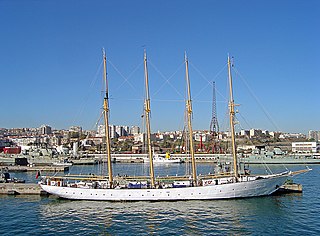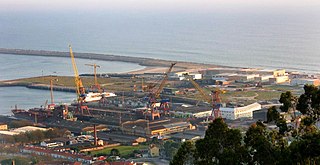
João Álvares Fagundes was an explorer and ship owner from Viana do Castelo in Northern Portugal. He organized several expeditions to Newfoundland and Nova Scotia around 1520–1521.

Viana do Castelo is a municipality and seat of the district of Viana do Castelo in the Norte Region of Portugal. The population in 2011 was 88,725, in an area of 319.02 km². The urbanized area of the municipality, comprising the city, has a population of approximately 36,148 inhabitants, although the extended densely populated region reaches surrounding municipalities like Caminha and Ponte de Lima with a population above 150,000 inhabitants. It is located on the Portuguese Way path, an alternative path of the Camino de Santiago, and at the mouth of the Lima river.

The 16th century in Canada saw the first contacts, since the Norsemen 500 years earlier, between the indigenous peoples in Canada living near the Atlantic coast and European fishermen, whalers, traders, and explorers.

Bacalhau is the Portuguese word for cod and—in a culinary context—dried and salted cod. Fresh (unsalted) cod is referred to as bacalhau fresco.

The Portuguese Navy is the naval branch of the Portuguese Armed Forces which, in cooperation and integrated with the other branches of the Portuguese military, is charged with the military defense of Portugal.

Sesimbra is a municipality of Portugal, in the Setúbal District, lying at the foothills of the Serra da Arrábida, a mountain range between Setúbal and Sesimbra. Due to its particular position at the Setúbal Bay, near the mouth of the Sado River and its natural harbour, it is an important fishing town. The population in 2011 was 49,500, in an area of 195.47 km². The present Mayor is Francisco Jesus.

São Jorge Castle, sometimes known in English as Saint George's Castle, is a historic castle in the Portuguese capital of Lisbon, located in the freguesia of Santa Maria Maior. Human occupation of the castle hill dates to at least the 8th century BC while the oldest fortifications on the site date from the 2nd century BC. The hill on which Saint George's Castle stands has played an important part in the history of Lisbon, having served as the location of fortifications occupied successively by Phoenicians, Carthaginians, Romans, and Moors, before its conquest by the Portuguese in the 1147 Siege of Lisbon. Since the 12th century, the castle has variously served as a royal palace, a military barracks, home of the Torre do Tombo National Archive, and now as a national monument and museum.

Valença, also known as Valença do Minho, is a municipality and a town in Portugal. The population in 2011 was 14,127, in an area of 117.13 km2.

UAM Creoula or NTM Creoula is a training ship of the Portuguese Navy, built in 1937 in the Companhia União Fabril (CUF) shipyards in Lisbon for the Parceria Geral de Pescarias fishing company. From 1937 to 1973 she was used in a total of 37 cod fishing campaigns in Newfoundland and Greenland, for a total of 300.000 nautical miles. Between 1973 and 1979 she remained moored in Lisbon. She was then bought by the Secretariat of State for Fisheries to become a fishing museum. However, during the repairs it was noticed that the hull was in excellent condition, so it was decided that the ship should sail again. She was converted into a Portuguese Navy training ship in 1987. The boat's coat of arms consists of two silver cod fish in an azure field under a granny knot.

Fishing is a major economic activity in Portugal. The country has a long tradition in the sector, and is among the countries in the world with the highest fish consumption per capita. Roman ruins of fish processing facilities were found across the Portuguese coast. Fish has been an important staple for the entire Portuguese population, at least since the Portuguese Age of Discovery.
António Carlos Bernardino Pedroto is a Portuguese former footballer who played as an attacking midfielder, and is a manager.
Gastão de Freitas Ferraz was a Portuguese spy working for the Abwehr. He was one of two radio operators on board the Gil Eannes, the codfish fleet support ship on the Atlantic. Ferraz almost succeeded in alerting the German military leadership to the imminent "Operation Torch" in 1942.

Estaleiros Navais de Viana do Castelo (ENVC) is a medium-sized shipyard in business since 1944, located in the town of Viana do Castelo, on the Atlantic Coast in the very north of Portugal. Occupying an area of 400,000 square metres and employing 625 people, it is a major Portuguese shipbuilder. In 2013 its assets and operations are sub-licensed to Martifer.
The high office of Admiral of the Kingdom of Portugal as the head of the Portuguese navy was created by King Denis of Portugal in 1317 for the Genoese nobleman and naval officer Manuel Pessanha. Although there is evidence that such a title existed before, it seems to have been of only a temporary character, for fleets assembled in times of war. The exception was perhaps Nuno Fernandes Cogominho who seems to have been appointed admiral by King Denis in 1307, and still had that title at his death in 1316, although the conditions are unclear. Nonetheless, Manuel Pessanha was the first person known to hold the title of Almirante-mor as a permanent office for a permanent fleet. All the king's galleys were under his jurisdiction. The conditions of the Pessanha's title stipulated that he must maintain a corps of at least 20 Genoese naval officers at all times and was obliged to serve the king in military service on land as well as sea.

The Castle of Beja is a medieval castle in the civil parish of Beja, municipality of Beja, Portuguese district of Beja.

Santa Maria Manuela is a Portuguese four-masted schooner. Originally a codfish fishing ship, Santa Maria Manuela is now used for sail training, hands on sailing holidays, environmental expeditions and team development programs. It belongs to Grupo Jerónimo Martins and is the sistership of the Portuguese Navy's Creoula.

Spain is an eminently maritime country with a long continental shelf running along the entire periphery of the Spanish coast. This narrow continental shelf is extremely rich in fish resources since the shelf is close to land.
Susanna Roope Dockery (1856-1927) was an English watercolour painter who lived both in England and in the city of Porto in Portugal. She mainly painted scenes of rural life in Portugal.




















